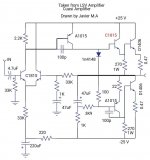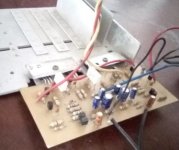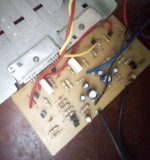After repairing a chinese audio system for a customer, I copied the diagram for the amplifier section which seemed so easy and single to me that I wanted to build one for my home. This amplifier does not pretend to be hi-fi or high quality therefore I built it keeping the same circuits as the original one. I know several circuits are missing to improve this amplifier but I wanted it to be as cheap as possible. I upload two photos and the diagram. The Amplifier is being supplied with +/-25V, cuasicomplementary output using TIP41C and it really sounds very well.
Attachments
Have the Chinese invented it again?
Classic scheme 1970. Amplifier Lina — Википедия
It has good sound when implemented correctly. Enjoy listening!
Attention! Damage to the transistors can damage the speaker. Use a shutdown circuit for DC protection through the speaker.
САМАЯ МАЛЕНЬКАЯ ЗАЩИТА АКУСТИЧЕСКИХ СИСТЕМ
Classic scheme 1970. Amplifier Lina — Википедия
It has good sound when implemented correctly. Enjoy listening!
Attention! Damage to the transistors can damage the speaker. Use a shutdown circuit for DC protection through the speaker.
САМАЯ МАЛЕНЬКАЯ ЗАЩИТА АКУСТИЧЕСКИХ СИСТЕМ
Last edited:
I said it was chinese because I got the diagram of a chinese amplifier which I repaired several months ago but now I read about its origin then I have to thank OldDiy for letting me know it. Yes, you are right, I have to put a DC protect circuit to prevent the speakers from any harmful output transistor. I will read the article you left, thank OldDiy ��
Attention! Damage to the transistors can damage the speaker. Use a shutdown circuit for DC protection through the speaker.
Just how much damage can a low wattage 25 volt power supply do to a speaker? Under that kind of a load you’d be lucky to see 20 volts. Even a cheesy 1” VC 6” speaker driver will take that for long enough to pull the power cord.
Not short enough
If one of the transistors shortens C-E out then there will be at least 25 Volts at the output. with a good PSU. Twice of the output power of the Max Pout
The speakers voice coil will not withstand that more than 5-10 seconds. If the Speaker withstand it then the speaker has already been damaged partly.
If the coils frame are aluminum, then the glue will melt and the coil will move free on the aluminum frame.
If the frame is Paper then the paper will burn coil wires Lacquer will burn. If it is epoxy, (rather seldom), then both the frame and the coil will be destroyed... same time
Never forget it's DC 25 @ 8 ohms are 3 Amps at 4 ohms are 6 amps.. Smoke signals will appear..out of the speaker. the only instance that not much happens is when PSU is WEEK or that there is a RAIL FUSE blowing at half of maximum power when output transistors shorten between C - E.
The .47 will blow later..most time those are oversized Resistors. usually 3 - 5 or even 10 watts. I see you use 2 or 3 watts. Use only 1 Watt that's is more than enough
Speaker Protections are made that no DC passes the loudspeaker above 1VOLTS RMS this equals 1.414Peak any DC VOLTAGE above this IS DANGEROUS for every speakers voice coil.. Take that for granted..Never mind the Wattage.
Just how much damage can a low wattage 25 volt power supply do to a speaker? Under that kind of a load you’d be lucky to see 20 volts. Even a cheesy 1” VC 6” speaker driver will take that for long enough to pull the power cord.
If one of the transistors shortens C-E out then there will be at least 25 Volts at the output. with a good PSU. Twice of the output power of the Max Pout
The speakers voice coil will not withstand that more than 5-10 seconds. If the Speaker withstand it then the speaker has already been damaged partly.
If the coils frame are aluminum, then the glue will melt and the coil will move free on the aluminum frame.
If the frame is Paper then the paper will burn coil wires Lacquer will burn. If it is epoxy, (rather seldom), then both the frame and the coil will be destroyed... same time
Never forget it's DC 25 @ 8 ohms are 3 Amps at 4 ohms are 6 amps.. Smoke signals will appear..out of the speaker. the only instance that not much happens is when PSU is WEEK or that there is a RAIL FUSE blowing at half of maximum power when output transistors shorten between C - E.
The .47 will blow later..most time those are oversized Resistors. usually 3 - 5 or even 10 watts. I see you use 2 or 3 watts. Use only 1 Watt that's is more than enough
Speaker Protections are made that no DC passes the loudspeaker above 1VOLTS RMS this equals 1.414Peak any DC VOLTAGE above this IS DANGEROUS for every speakers voice coil.. Take that for granted..Never mind the Wattage.
Last edited:
very crude. probably runs in class B due to the single 1N4148 being used as the biasing... probably the only reason it doesnt thermally run away and explode...
You could try 2030 or 1875 kits from China, about $2 each, shipping extra of course.
Or find one second hand.
TIP 41 here about 40 cents each long back.
DC to a speaker will fry it, details above.
Use a capacitor to filter DC, and even then measure DC during play.
Or find one second hand.
TIP 41 here about 40 cents each long back.
DC to a speaker will fry it, details above.
Use a capacitor to filter DC, and even then measure DC during play.
Last edited:
Thank you all for giving your opinions. In the original amplifier, the only protect circuit that was used was an overload detect monitoring one of the emitter resistors of the output transistors but no DC detect. Yes, Bias circuit by 1N4148 + 100R. The amplifier was working for several hours. OldDiy, I was checking the DC detect and it looks very easy. One day, I will build it.
I hope you build it before the amp blows up..
Take a 1A FUSE in series with the + lead of Speaker Cable, that will do for the moment.
Yea Speaker Protection Circuit cost 10 Dollar to buy, or 30 minutes to build if you buy a KIT, compared with either buying new Speakers or get that Voice coil exchanged, which will degrade the sound, never mind how good the person is who exchange it.. It's a big difference in money and time and last also in listening experience you finally spent, and the knowledge that it could be prevented from beginning. to happen. And it comes always at the time when you are not there to pull the plug fast enough..
Things like that would drive me mad, Mad at myself not to give it enough importance...
Regards Chris
Take a 1A FUSE in series with the + lead of Speaker Cable, that will do for the moment.
Yea Speaker Protection Circuit cost 10 Dollar to buy, or 30 minutes to build if you buy a KIT, compared with either buying new Speakers or get that Voice coil exchanged, which will degrade the sound, never mind how good the person is who exchange it.. It's a big difference in money and time and last also in listening experience you finally spent, and the knowledge that it could be prevented from beginning. to happen. And it comes always at the time when you are not there to pull the plug fast enough..
Things like that would drive me mad, Mad at myself not to give it enough importance...
Regards Chris
Thank you Chris for your suggestions. I will take all the preventions to avoid any damage if any output transistor is shortcircuited. I was seeing the DC protect circuit that OldDiy linked and it is very easy and cheap to build. I use one more complex but it works ok some day I will upload it here. Offset voltage is 15mV and 35mV for both channel. Although I have built many amplifiers for several years, I am still learning from opinions of who answer to the threads that I have created here. Thank you very much.
- Home
- Amplifiers
- Solid State
- Very cheap amplifier: construction.


